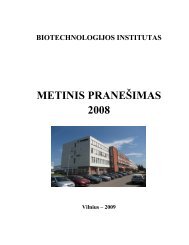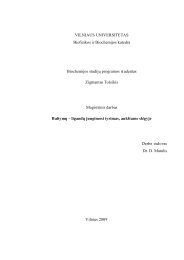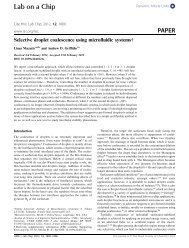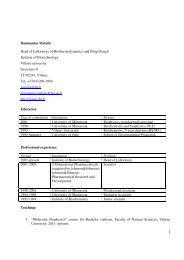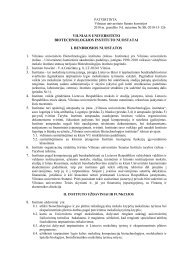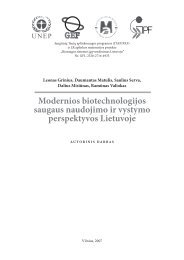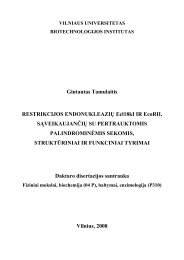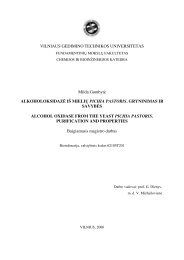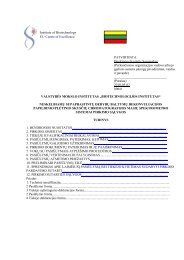Report 2008-2010
Report 2008-2010
Report 2008-2010
You also want an ePaper? Increase the reach of your titles
YUMPU automatically turns print PDFs into web optimized ePapers that Google loves.
INSTITUTE OF BIOTECHNOLOGY:<br />
The history of the Institute of Biotechnology is very much the history<br />
of the modern biotechnology in Lithuania. Founded in 1975 as<br />
the all Union Research Institute of Applied Enzymology, having gone<br />
through a lot of restructuring, it has been carrying out the activities<br />
under the name of Institute of Biotechnology since 1995. A major difference<br />
exists between the Soviet (1975-1990) and post Soviet (1990-<br />
<strong>2010</strong>) periods of the Institute. In the first period, its activities depended<br />
upon the decision of the Central Board of Microbiological Industry of<br />
the Soviet Union Council of Ministers (Glavmikrobioprom) and were<br />
directed to the development of technologies for:<br />
• production of highly purified enzymes for molecular biology, analytical<br />
and medical purposes;<br />
• production of industrial (bulk) enzymes on a large scale and preparation<br />
of manuals for their application.<br />
Bacterial strains producing well-known restriction enzymes and methyltransferases<br />
were obtained and the schemes for their purification were<br />
developed, thus providing home market with the tools for molecular<br />
biology. In parallel, a search for new restriction enzymes competitive<br />
on the international market was started on own initiative resulting in<br />
the discovery of 30% of restriction-modification enzymes currently<br />
known world-wide.<br />
Besides the investigation of restriction enzymes the Institute was involved<br />
in the development of technologies for purification of enzymes<br />
for diagnostics and enzymatic analysis. Highly purified glucose oxidase<br />
was widely applied for the determination of glucose in biological liquids.<br />
Technologies for obtaining functionally pure phospholipases C<br />
and D, acetylkinase of a microbial origin were developed as well. In<br />
parallel, sorbents for enzyme purification were synthesized. Technologies<br />
for producing horseradish peroxidase, lactate-dehydrogenase,<br />
mitochondric malate-dehydrogenase, yeast glucose-6-phosphatedehydrogenase<br />
and hexokinase, flavocytochrome b2, formate-dehydrogenase<br />
and other were developed. Usually, properties of these<br />
enzymes surpassed characteristics of similar enzymes produced by foreign<br />
companies.<br />
Improvement and modification of methods for the measurement of<br />
enzymatic activities , development of new assay methods, as well as of<br />
methodologies for building substrate-detecting analytical equipment<br />
(biosensors) via the employment of immobilized enzymes, quality<br />
control of highly purified enzymes and studies of their physical-chemical<br />
properties were among the tasks of the Institute till 1990.<br />
On the other hand, the Institute together with Vilnius Enterprise for<br />
Bulk Enzymes developed technologies for production of enzymes in<br />
large scale for use in industry and agriculture. For example, fungal enzymatic<br />
preparation Maltavamarin G10X for fur industry, bacterial glycosidase<br />
and lysozyme, multienzymatic compositions MEK-LP and<br />
MEK-GPL for poultry farming and cattle-rearing, multienzymatic composition<br />
MEK-1 for wine industry, acid-resistant Fermosorb and<br />
Polyferm for use in veterinary, and lysosubtilin G10X.<br />
In 1984, the investigation of recombinant proteins for medical purposes<br />
and the development of their technologies were started at<br />
the Institute. Technologies for production of alfa2b-interferon, gamainterferon,<br />
beta-interferon, tumour necrosis factor and interleukin-2<br />
were developed and the biological properties of these proteins were<br />
studied. Later on, the technology for production of recombinant<br />
human growth hormone was developed. Due to joint research with<br />
the Institutes of the Academy of Sciences of the Soviet Union, the tertiary<br />
structure of recombinant human growth hormone was determined<br />
for the first time.<br />
In 1986, studies related to ecological biotechnology were initiated at<br />
the Institute. Investigations of Pseudomonas putida were carried out<br />
and the substance for decomposition of petroleum pollutants in the<br />
environment was developed under brand name Putidoil and tested<br />
closely with the scientists from the Siberian institutes.<br />
In 1987, facilities for a large-scale production of highly purified enzymes<br />
were built. However, it became clear that the demand for such enzymes<br />
was lower than it had been anticipated, and the facilities were<br />
applied for the production of recombinant proteins for medical purposes.<br />
The technology for production of human recombinant alfa2binterferon<br />
was developed and the interferon was registered in the<br />
USSR in early 1990 and in many other countries later on under the<br />
brand name Reaferon .<br />
By 1990, a strong team of over 700 employees was built at the Institute.<br />
The basis for scientific research and international trade of restriction<br />
endonucleases and other enzymes involved in metabolism of nucleic<br />
acids was laid. Technologies for production of recombinant proteins<br />
were developed, new strains for production of enzymes were discovered,<br />
and many laboratory and pilot manuals for the manufacture of<br />
highly purified, industrial and immobilized enzymes were developed.<br />
To keep up a high level of applied research, the fundamental investigations<br />
were also carried out in the Soviet years. Over two hundred<br />
and seventy scientific manuscripts in the all-union scientific journals<br />
(“Biochimija”, “Molekuliarnaja biologija”, “Bioorganičeskaja chimija”,<br />
“Doklady AN SSR” etc.) and peer reviewed international journals (“Nucleic<br />
Acids Research”, “Enzyme and Microbiological Technology”,<br />
“Biotechnology and Bioengineering”, “Applied Biochemistry and<br />
Biotechnology”, “Chromatographia”, “Biochemistry Journal”, “Analytical<br />
Biochemistry”, etc.), were published; 211 patents valid in the former<br />
USSR were granted.<br />
In 1990, after re-establishment of independence of Lithuania and gaining<br />
the status of a state research institute, it became clear that a major<br />
part of developed products were not competitive on the international<br />
market, except for DNA restriction and modification enzymes, and several<br />
human recombinant proteins. Hence, restructuring was unavoidable<br />
for the survival of the Institute. The reorganization was<br />
undertaken by separating basic and applied research with the establishment<br />
of the Molecular Biology Centre and the Centre of Genetic<br />
Engineering and Pharmaceuticals in 1993. In two years, these<br />
centers evolved into spin-offs, namely, Fermentas (presently ThermoFisher<br />
Scientific) and Biofa (presently Sicor Teva). After two companies<br />
settled apart, the priorities of the Institute, whose name was<br />
shortened to the Institute of Biotechnology (IBT), have been focused<br />
and concentrated in the field of modern biology-biotechnology to:<br />
• genetic and molecular studies of restriction-modification phenomenon;<br />
• function of genes in yeast;<br />
• research and development of recombinant biomedical proteins;<br />
35 th anniversary<br />
6



